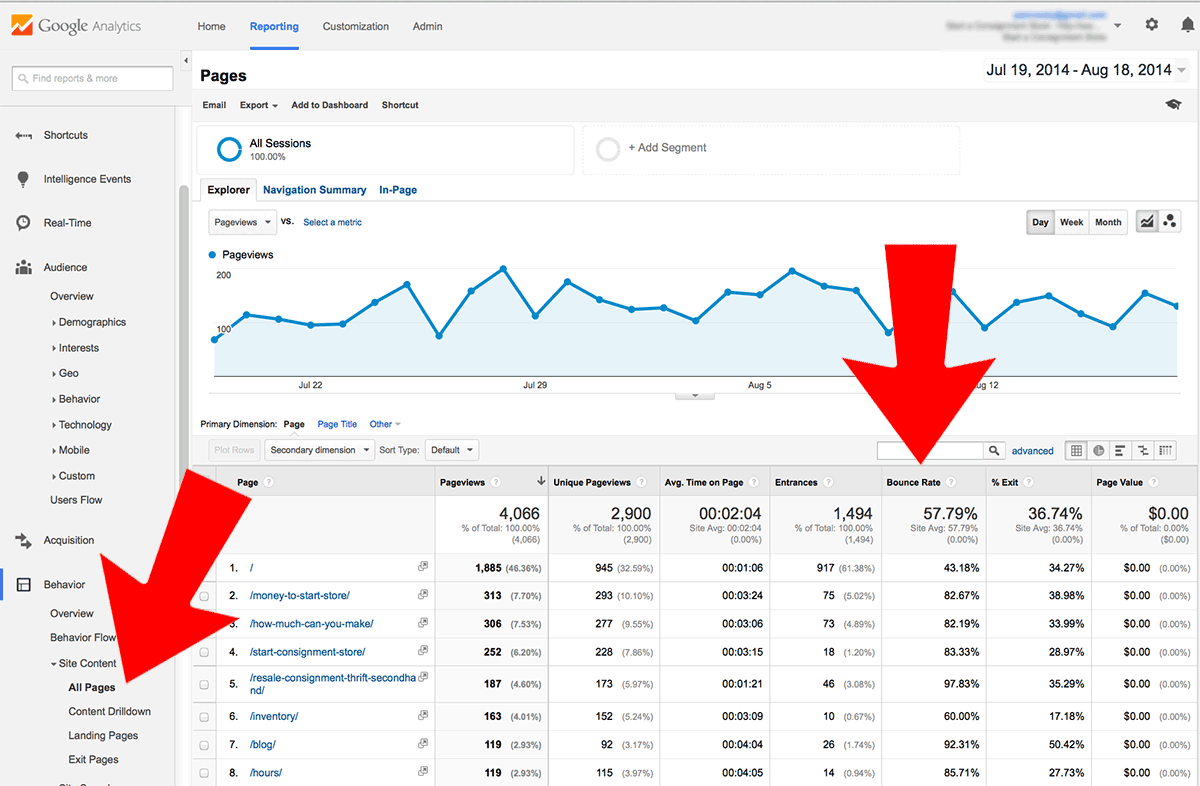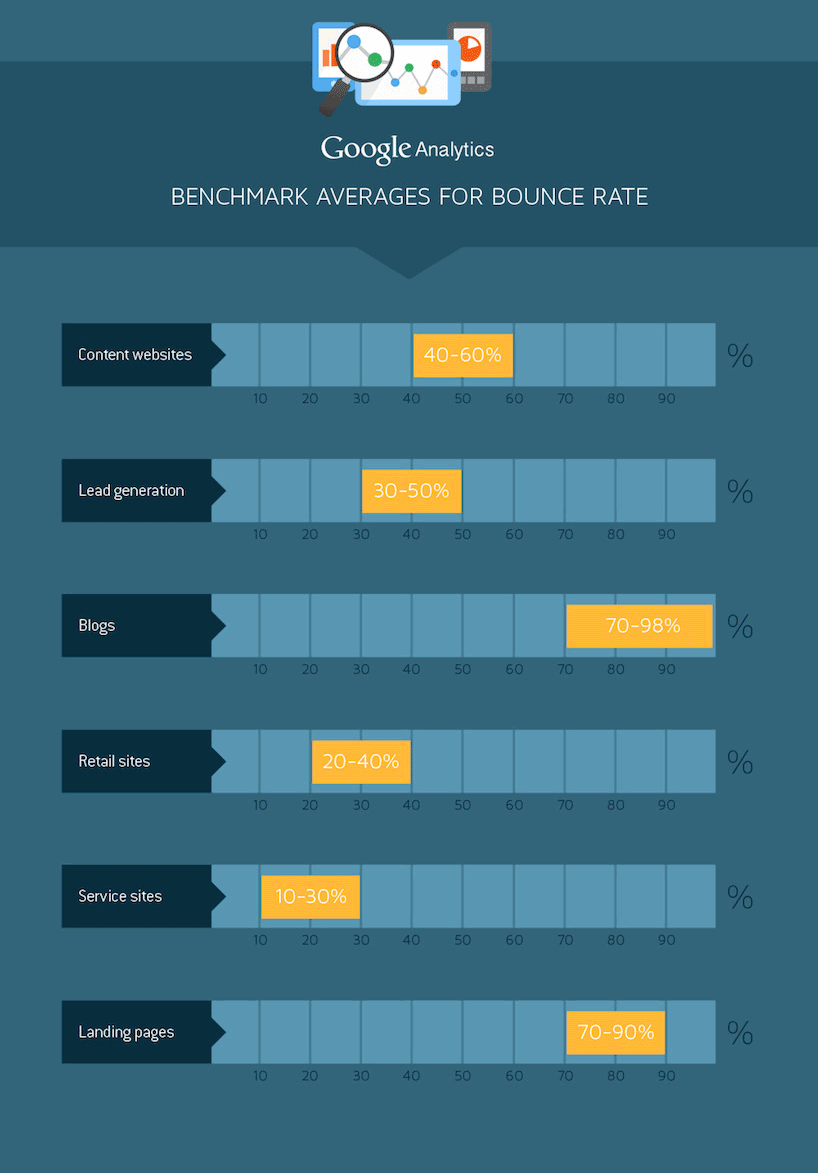Bounce rate seems like a straightforward metric, but the moment you scratch it’s surface, things get murky. Even the definition is murky. The Google Analytics help center defines bounce rate as “the percentage of single-page sessions (i.e. sessions in which the person left your site from the entrance page without interacting with the page).” That seems pretty straightforward, until you learn that your Google Analytics reports don’t precisely reflect that definition. Bounce rate also doesn’t track scrolling, which is one of the key ways people interact with a page. Someone could land on one of your blog posts, read it all the way through, and then click back to the search results. That visitor would be defined as a bounce.
There are other examples of how murky bounce rate can be, but I’ll spare you the SEO hairsplitting. The important thing to know, and really the only thing you need to know is that bounce rate is a relative measurement. All you need is a bounce rate lower than your competitors.
How to find out what you site’s bounce rate is
You can see the bounce rate for your entire site from the Dashboard view of your analytics account. Google will give you the bounce rate for each individual page pretty much anytime you see a listing of pages. You can also go to the far left navigation column, find “Behavior” > “Site Content > “All Pages” and you’ll see something like this (without the arrows, of course):

Here’s how to find the bounce rate for your site’s most visited pages. The left arrow shows where to find this view in the Analytics navigation. The right arrow points out the bounce rate column in the report.
Average bounce rates for different kinds of sites and devices
Before you panic about what you see in your Analytics account, consider this:

Bounce rate varies widely across different types of websites. This segment of the infographic “How to Decrease Your Bounce Rate” from QuickSprout shows bounce rates from 10% to 90% depending on the site type.
If that’s not enough to make you feel better, check out RocketFuel’s graph showing bounce rates across different device types:

Remember: Bounce rate is relative. All that really matters is that your site’s bounce rate is lower than your competitors’. Just to make sure it is, here are the most common causes of high bounce rates and how to fix them:
1. You’ve got a single page site.
This is obviously going to make people less likely to click to another page… because there is no other page. You’ll also see this cause of high bounce rates for landing pages. You can see it right above in the bounce rate averages image from QuickSprout. Landing pages have average bounce rates of 70 to 90%.
But can you still get the bounce rate down? We’ll address a lot of these fixes later in more detail, but for starters, make sure your page looks good on mobile devices, loads fast, and has a clear call to action. If you’re still seeing a bounce rate of more than 90% consider refining the flow of traffic to this page, or consider adjusting the site to better suit that stream of traffic.
2. Google Analytics is not installed correctly.
This happens more often than you’d think. If you have an extremely high (over 90%) or extremely low (less than 10%) bounce rate, make sure your Google Analytics installation hasn’t gotten messed up somehow. Look for radical drops or jumps in your bounce rate from one day to the next
Something like this is an example of a bad Analytics install:

A bad Google Analytics installation is one of the most common causes of a very high (90% or more) or a very low (10% or below) bounce rate.
3. Your site loads slowly.
Website visitors will not tolerate slow sites anymore. This is especially true of mobile visitors. Slow sites kill just about any kind of engagement, including bounce rates.
This segment of an infographic from Red Website Design illustrates it well:

Page load time has a powerful influence over bounce rates.
4. Your pages’ navigation is confusing.
This is another major offender. Use common website design conventions for your site’s navigation. Creativity is great, but not when it interferes with how people expect a webpage to work. Basic examples of improving site design are to have the logo linked to your homepage and to have a site-wide footer with links that can bring people to major sections of your site.
It makes sense navigation would have such a powerful effect on bounce rate. Bounce rate measures whether people click or not. Navigation shows people where to click.
5. Your website isn’t mobile friendly.
As of earlier this year, half of the traffic on the Internet comes from mobile devices. If your page doesn’t look good or doesn’t work on the major mobile devices, you’ll see high bounce rates.
When SEO firms start work on a site to improve its bounce rate, one of the first things they’ll do is to update the design so it looks good on mobile devices. Usually this is referred to as making the design “responsive”, so it automatically adjusts its layout to different devices.
Even if your bounce rate is good, if your site isn’t using responsive design by now, then you need to move that up to the top of your to do list.

Pages that aren’t mobile friendly can get very high bounce rates.
If you are thinking about modernising your website, take a look at our collection of 100+ responsive website templates! Choose from a wide range of designs, customize to your heart’s content, and get online in no time.
6. Your call to action isn’t clear.
At first blush, this would apply to only landing pages, but it actually does apply to home pages, blog posts and pretty any other page on your site. Every page needs a clear call to action, whether that’s signing up for the email list, reading a related blog post, or filling out a form on a landing page.
As much as 80% of the traffic to your website may be going directly to the interior pages, not to the home page. Home pages typically get 20 to 40% of incoming traffic. So while it’s important to make the home page of your site have a clear call to action, in a sense every page on your site is a landing page.
7. Your site’s pop-up is repelling visitors.
Pop-ups are great (because they get great results for list-building), but if you are troubleshooting a really bad bounce rate, try turning the pop-up off and see if bounce rate goes down. If your bounce rate does drop after the pop-up is gone, there are two possible interpretations:
- Whatever you’re offering in the pop-up is not interesting to your visitors
- Your audience is particularly pop-up phobic
Even if your audience just hates pop-ups, there’s an easy solution. Don’t show the pop-up until they’ve been on your site for a bit. Showing a pop-up the moment people land on a page is not a best practice. You’ll get more opt-ins if you delay it.

Sites with this many ads usually have a high bounce rate.
8. There are too many ads.
Is more than 40% of the space on your page ads? Most visitors don’t like that. Try removing a third of the ads on the page and see if the bounce rate improves.
Cutting a third of the ads on a page doesn’t have to crush your site’s earnings. Just run an ad performance report. When you start removing ads, delete the worst performing ads first. Usually cutting your 1/3 worst performing ads will initially reduce revenue by 10-15%. Over time, you’ll actually make more money because people will stay on your site longer, and be more likely to come back.
9. Write for scanners, not readers.
As a writer, it pains me to tell you this, but people don’t read much online. Most of the time they’re scanning. If they come across a page with really long paragraphs, many will leave. It’s because you made the page look hard to read.
Fortunately, this is an easy fix. Follow these suggestions to make your writing more scannable:
- No paragraphs longer than 5 lines
- Aim for paragraphs of 3-5 sentences
- Use bullets wherever possible (any time you refer to more than 2 things is an opportunity)
- Use subheads
- Use images
- Don’t use a fancy word when a simple one will do
- Break long sentences up
10. Have the page suit the traffic.
It’s too bad Google removed referrer keyword reports earlier this year (referrer keywords are the keywords people use to come to our sites). Now we only see the frustrating “keyword not provided” in our Analytics accounts. As of April of this year, even AdWords accounts no longer show referral keywords. But we still have the Google Webmaster Tools “Search Queries” data.
Despite the shortcomings of Google Webmaster Tools, the Search Queries report is one of the best ways to know what people expect to find on a page. Check your Search Queries report for pages with bounce problems – there may be a gap between what people are expecting and what the page is actually about.
If you’ve optimized your pages according to all the above suggestions and you’re still seeing a bounce rate you don’t like, try to either clean up the stream of traffic to that page or adjust the page to suit the traffic. For example, if it’s AdWords traffic, add some negative keywords. If it’s Facebook traffic, make the landing page look more like Facebook.
Those ten techniques will get you a long way towards improving the bounce rate of your pages. Just remember – you don’t need a 0% bounce rate. You just need to beat the sites you’re directly competing with in the search engine results.
